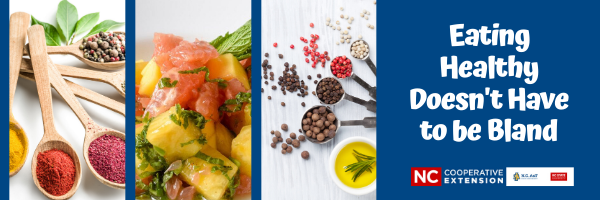Eating Healthy Doesn’t Have to Be Bland
go.ncsu.edu/readext?696770
en Español / em Português
El inglés es el idioma de control de esta página. En la medida en que haya algún conflicto entre la traducción al inglés y la traducción, el inglés prevalece.
Al hacer clic en el enlace de traducción se activa un servicio de traducción gratuito para convertir la página al español. Al igual que con cualquier traducción por Internet, la conversión no es sensible al contexto y puede que no traduzca el texto en su significado original. NC State Extension no garantiza la exactitud del texto traducido. Por favor, tenga en cuenta que algunas aplicaciones y/o servicios pueden no funcionar como se espera cuando se traducen.
Português
Inglês é o idioma de controle desta página. Na medida que haja algum conflito entre o texto original em Inglês e a tradução, o Inglês prevalece.
Ao clicar no link de tradução, um serviço gratuito de tradução será ativado para converter a página para o Português. Como em qualquer tradução pela internet, a conversão não é sensivel ao contexto e pode não ocorrer a tradução para o significado orginal. O serviço de Extensão da Carolina do Norte (NC State Extension) não garante a exatidão do texto traduzido. Por favor, observe que algumas funções ou serviços podem não funcionar como esperado após a tradução.
English
English is the controlling language of this page. To the extent there is any conflict between the English text and the translation, English controls.
Clicking on the translation link activates a free translation service to convert the page to Spanish. As with any Internet translation, the conversion is not context-sensitive and may not translate the text to its original meaning. NC State Extension does not guarantee the accuracy of the translated text. Please note that some applications and/or services may not function as expected when translated.
Collapse ▲
We have all been told “Eat your vegetables…they are good for you.” We just didn’t know how good they taste if you add some spices.
Fruits and vegetables provide vitamin A (and beta carotene) and C. Some are also good sources of folate, potassium, calcium, magnesium and iron. Each of these nutrients helps your body function, while reducing the risks of some cancers, heart disease, and other health problems. The latest research shows that by including more fruits and vegetables in our diet, Americans can decrease risk of many chronic diseases.
The key to adding more of those good fruits and vegetables is to go for the taste and eat a wide assortment. A good rule of thumb is to eat at least three different colors each day.
A great way to increase fruit and vegetable servings for yourself and your family is to make them readily available to eat. That’s especially true for kids and teenagers. To make eating fruits and vegetables fun, try these ideas:
- Clean carrots and celery, then cut into bite-size snacking pieces, or buy bags of baby carrots and chopped, ready-to-eat vegetables.
- Keep a bowl of colorful assorted fruit on the counter to remind the family to help themselves.
- Offer crisp broccoli and cauliflower florets for dipping and in salads. They taste best and keep longer when blanched for a minute in boiling water and then refreshed in ice water. Drain well and chill.
- Have dried fruit – such as raisins or apricots on hand for snacks, or lunch boxes.
- Let the kids “decorate” pizza with fresh, cut-up vegetables, such as sliced tomatoes, zucchini, or mushrooms.
- For warm weather treats, try freezing fresh fruit like seedless green and red grapes. Dip slices of banana into lemon juice and stick in a toothpick before freezing.
- Add pureed vegetables to sauces and casseroles.
- Mix chopped or grated vegetables such as broccoli, carrots, and zucchini, into your pasta sauces.
Research shows that including more fruits and vegetables in our diet keeps us health. This tasty recipe is a way to “spice up” a fruit salad in a healthy and delicious way. While the recipe calls for grapefruit, mango, and pineapple, you could use most any combination of fruit.
Chili Lime Salad with Grapefruit, Mango and Pineapple
Ingredients:
Salad:
- 2 grapefruit, cut into sections
- 2 mangos, chopped
- ½ pineapple, chopped (can use canned – discard juice
Dressing:
- 2 tablespoons vegetable oil (canola, grapeseed, or sunflower seed)
- 2 tablespoons white-wine vinegar
- 1 tablespoon finely chopped jalapeno
- ½ cup finely chopped fresh mint leaves
- Juice and zest of 1 lime
- 1 tablespoon sugar (or less)
- Pinch cayenne pepper
- Salt and pepper to taste
Directions:
- Place the fruit in a large bowl, cover, and refrigerate.
- Make the dressing using a screw top jar or plastic container with a tight fitting lid.
- Place all dressing ingredients in the jar or container and shake to combine.
- Pour over the fruit and stir.
- Serve immediately or chill until serving.
Serving Size: 1¼ cup
For more great recipes go to the new Mediterranean way of eating website: Med Instead of Meds




